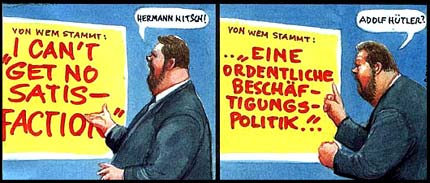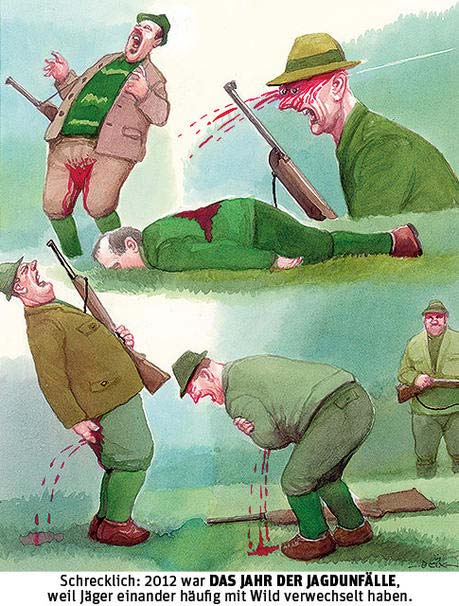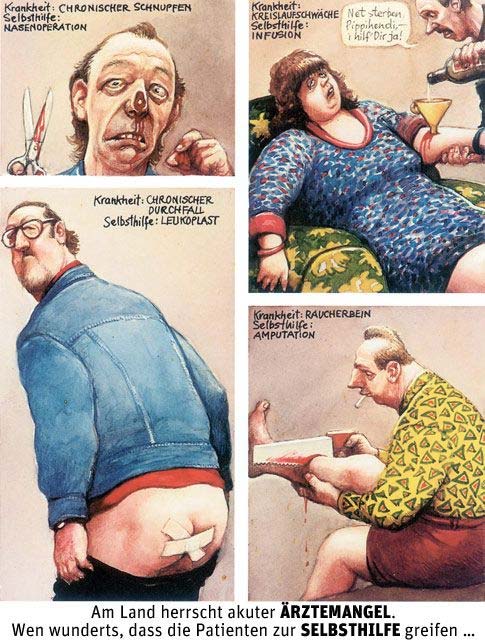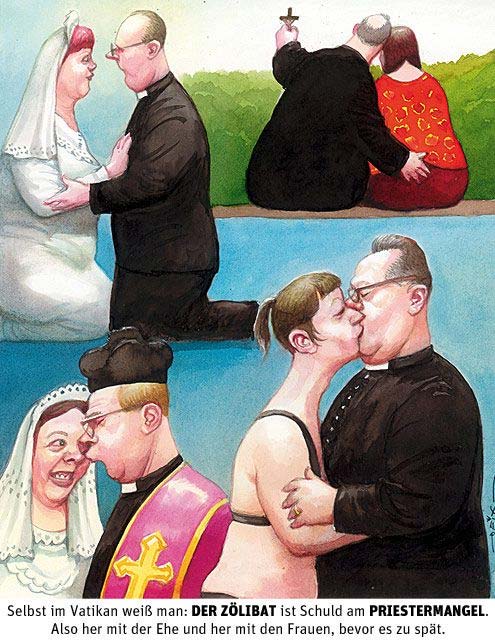Manfred Deix cartoon from the 1980s. Translation: "More women in male professions!"
Manfred Deix was an Austrian caricaturist, illustrator, painter, editorial cartoonist and musician. His instantly recognizable style is characterized by gorgeously rendered aquarel illustrations, portraying chubby people with grotesque physical features. Deix was a masterful and vicious satirist. In his cartoons, he commented on real-life Austrian and international politicians, but also more general portrayals of the ills of modern-day society. In his home country, his name even spawned an eponym ('Deixfigure') for people who look like his drawings. Deix' uncompromising, unflattering caricatures repulsed and outraged many readers. Several times throughout his career, he was sued for defamation and blasphemy. He received death threats and was subject of protest letters and attempts to ban him. But simultaneously, he also gained a strong cult following and won various awards. One of his final projects was an animated feature film, partially based on his youth, presented in his familiar style. It was posthumously released as 'Rotzbub' (2021), becoming the first Austrian-made feature-length animated film.
Comic strip by Manfred Deix. The man is given quotations and has to guess who said them.
Early life and career
Manfred Deix was born in 1949 in the lower Austrian town of St. Pölten, as the second child of Johanna and Franz Deix. His father had lost an arm fighting in Russia during his military service in World War II. Originally a grocerer, he now ran an inn in Bohemkirchen, named 'Zur blauen Weintraube'. In this tavern, Deix witnessed sleazy barhoppers, pathetic drunks and itchy imbeciles who got aggressive under the influence of liquor. Even the village priest got drunk and enjoyed pinching the waitresses' buttocks on the sly. Whenever somebody had to babysit little Manfred, his parents brought them to their neighbors, who were a lesbian couple. Still, most people in his neighborhood were conservative and conventional Roman Catholics, some of whom hadn't fully given up their Nazi sympathies from the previous war. Several war veterans were invalid too. Growing up among such colorful, eccentric people influenced Deix' worldview and gift for observational comedy. Deix' brother, Christian Deix (1964) also gained fame in adulthood as a musician.
While his parents hoped that he take over their inn, Deix was more interested in cartooning. At age nine, Deix already constructed an erotic flip book featuring 100 drawings of a woman undressing. He also sold nude drawings like these to his schoolmates. Ironically, none other than his Religion teacher helped him publish his first comic strip in the Roman Catholic weekly Niederösterreichischen Kirchenzeitung: 'Unter der Sonne Afrikas' ('Under the African Sun'). Deix was 11 at the time. The plot was based on a girl scout novel about a group of explorers who save an Arab boy from a group of Tuaregs, whereupon the kid predictably decides to become a Roman Catholic Priest. Interviewed by Peter Pisa for Kurier (12 November 2012), Deix later dismissed this deadly serious, preachy and moralistic text comic as "incredibly dull" and admitted that he only got the job because his religion teacher was a closet pedophile who "liked him", but suppressed his sexual urges.
In 1965, Deix enrolled at the Federal Graphic Education and Research Institute in Vienna, together with his friends Bernhard Paul, Josef Bramer and Gottfried Helnwein. Since they skipped so many lessons, they were kicked out after two and a half years. Deix continued his studies at the Schillerplatz Academy of Fine Arts in Vienna, which he also left in 1975 (!) after 14 unsuccessful semesters. His only motivation to be at the Academy was avoiding the military draft. His main graphic influences were Carl Barks, Wilhelm Busch, Robert Crumb and Erich Sokol.
Cartoon by Manfred Deix. Translation: "Horrifying: 2012 was the year of hunting accidents, when several hunters confused one another with wild."
Cartooning career
By 1972, Deix published his first professional work in magazines like Profil, Trend and Economy. Between November and December 1973, he adapted Wolfgang Kudrnofsky's novel 'Klappe, Mr. President' into a comic strip, serialized in Neue Freie Presse. He also made cover drawings for Stern, Der Spiegel, Pardon, Tempo, Titanic, Die Zeit, Charlie Hebdo and Playboy. Between 1991 and 1995, he appeared in Krone. From 1992 until March 2015, Deix had a weekly cartoon in the news magazine News. In 1980, his first book 'Cartoons von Manfred Deix' was published. Several collections followed, such as 'Cartoons de Luxe' (1983), 'Satiren aus Wien' (1985), 'Mein Tagebuch' (1986), 'Der dicke Deix' (2004) and 'Der heilige Deix' (2013). In 1994, his work was also released on CD-ROM.
Cartoons by Manfred Dix. Translation: "There has been an accute shortage of doctors for a while. Unsurprisingly, patients resort to self-remedy."
Style
Deix made cartoons with gentle watercolors, often accompanied by dry, ironic commentaries. Most resemble text comics, with text printed underneath the images, but others use speech balloons too. Stylistically, they resemble a children's picture story, with sentences set to rhyme and certain nouns printed in bold lettertype. However, in sharp contrast, the content is viciously satiric and taboo-breaking. A typical Deix character is a pathetic, ugly, corpulent, pear-shaped nincompoop. In Austria, the term 'Deixfigur', referring to people who look like his characters, was included in the official dictionary. It amused Deix that people often told him that "my neighbor looks just like one of your characters", all while not realizing how much they resembled one themselves.
Deix was a master in satirizing his fellow countrymen, but while deeply rooted in Austrian culture, his characters are also universally recognizable human archetypes. He portrays them at their least flattering, as mindless consumers, passive TV watchers, narrow-minded racists, gullible churchgoers, sleazy porn addicts, corrupt businesspeople, ...These ignorant slobs are depicted with big noses, dumbo ears, protruding chins and teeth, saggy body parts, flabby breasts, beer bellies, warts, zits, wounds, ulcers, ejaculation stains,... To push the ickyness, Deix also portrays these lowlifes guzzling down alcohol, smoking like chimneys, stuffing themselves with junk food, masturbating, having sex, going to the toilet, or getting severely wounded.
Stylistically, his illustrations are often confused with fellow cartoonist Gerhard Haderer. Interviewed by Profil in 2009, Deix said that he therefore added a little crown on top of the "i" whenever he signed his art, to give more visual clarification that he drew it.
Controversy
Over the years, Deix' cartoons offended countless people. The satire itself was enough to set readers off, but the unflattering, naturalistic, flesh-colored aquarel drawings, complete with scenes of sex and gruesome violence, also repulsed many. In some magazines, disgusted and outraged readers instantly canceled their subscriptions. Others threatened Deix by phone, send him turds in his mailbox, or cut his car tires. Chief editor Hans Dichand of the Kronen Zeitung once fired him over a cartoon many readers considered blasphemous, but, as Deix added wrly, "...also because I wasn't punctual with my deadlines". Deix was sued more than six times. In 1994, for instance, over a cartoon ridiculing Jesus as a flirtatious, weepy individual, which led to a sentence for blasphemy, though he won his case in appeal. On 11 December 2009, three Catholic clerics in Vienna sued him again for two cartoons on the website NEWS.at , which satirized the prohibition against crucifixes in schools and depicted God.
Deix frequently portrayed real-life Austrian politicians, like former Nazi Kurt Waldheim, who later became post-war President of Austria and secretary-general of the U.N. Waldheim had lied about his membership of the S.A., later claiming he just had a "desk job", but was still able to remain in power. On 11 March 1986, Austrian Chancellor Fred Sinowatz said that Waldheim "hadn't been an official member of the S.A. cavalery., but his horse was." This led to Deix drawing a caricature of Waldheim in Nazi uniform, seated on a horse, telling the animal: "It's your fault if I later get in trouble, stupid asshole!". The cartoon caused colossal controversy, but also expanded Deix' international fame by being reprinted in many foreign media.
Another recurring target was far-right politician Jörg Haider (FPÖ). Deix had followed his career ever since Haider became a rising force within the FPÖ party in the 1970s, eventually gaining international notoriety in 2000, when the Austrian conversative party ÖVP formed a coalition government with the FPÖ, marking the first time since World War II that a far-right party was included in a European government. Haider felt deeply offended by Deix' cartoons and registered several complaints against his work. Other famous Austrians who vocally expressed their disgust over Deix' work were chancellor Bruno Kreisky, comedian Helmut Qualtinger (Remigio the bearded monk in 'The Name of the Rose', 1986) and writers Thomas Bernhard (of 'Correction' fame) and Elfriede Jelinek (of 'The Piano Teacher' fame).
'Grazer Bürgerwehr', 2002. The police officers try to "catch" a drug dealer by using "a black man" as bait. To lure the bewildered passerby, they use a banana.
Graphic contributions
In 1987, Deix designed theater sets for Bertolt Brecht's play 'Arturo Ui', produced by the Viennese Burgtheater. He also made masks for Ernst Krenek's opera 'Kehraus um St. Stephan' (1990) and designed the facade of the Wind Palace (1999), for multimedia artist André Heller. Between 2009 and 2010, he used his graphic talent to promote the animal welfare movement and Animal Rights Party. The lifelong chain smoker also saw no qualms in drawing ads for cigarette brand Casablanca.
Deix was also active as a musician and a huge fan of The Beach Boys. The only time he ever traveled outside Austria was in 1984, to go to California, where he personally met the band. During a trip to Las Vegas that same vacation, he officially married his wife. In 1995, Deix covered some Beach Boys songs, albeit sung in Viennese dialect and released it as the album 'Musik Aus America' (1995), of which he also illustrated the cover. Yet all covers were sung in Viennese dialect, some in duet with Austrian comedian Lukas Resetarits. During the Donauinselfest in Vienna (1999), Deix sang three numbers on stage with The Beach Boys.
Recognition
Deix received many awards throughout his career. The city of Vienna bestowed him with the Johann Nestroy Ring (1988) and Gold Medal of Achievement (2005). The city Kosterneuburg honored him with a Culture Award (2000), while the German province Nieder-Osterreich gave him the Golden Honorary Medal of Achievement (2009). He also received the Swiss Golden Press Award (1997). In 2009, the Hamburg University of Applied Science offered Deix the title of Professor. In 2012, he won the Österreichischer Kabarettpreis (Austrian Cabaret Award).
In 1986, his cartoons were exhibited in the Gallery at the Berlin Chamissoplatz. In Vienna, they were on display in the Palffy Palace (1988), while in the City Museum of Heilbronn they could be seen during a 1990 expo. In 1991, Deix was subject of three exhibitions, held in the Wilhelm Busch Museum in Hannover, the Museum of Art & Industry in Hamburg and the City Museum of Ludwigshafen. In 2000, the 'Good Vibrations' expo was held in the Kunsthaus in Vienna. Deix' art was also on display in the Kunsthaus Köflach (2003), Historical Museum of Frankfurt am Main (2004), Wilhelm Busch Museum in Hannover (2007) and Ludwig Galerie Schloss in Oberhausen (2008). Between 21 February and 24 November 2017, the Kunstkammer Würth organized another exhibition dedicated to his work. Other posthumous exhibitions have been held in Castle Tabor (16 September - 22 February 2024).
Since 2001, Deix' work is part of a permanent exhibition in the Caricature Museum in Krems. Over the years, they've organized several thematic expos based on his work.
Final years and death
For most of his life, Deix lived near Vienna with his wife and about 80 cats. His daily activities consisted of "drawing, smoking and boozing". In 1988, he had to be hospitalized because of a pulmonary emobilism. He moved to Klosterneuburg-Weidling, but didn't give up his unhealthy habits. In 1995, he collapsed again. In 2014, he suffered from a pulmonary infarction, which motivated him to quit smoking in favor of the e-cigarette. Despite everything, he never considered retirement. Interviewed by Wolfgang Paterno (16 February 2009) for Profil, Deix explained that he was a compulsive artist and compared himself with rock musician Chuck Berry: "Chuck Berry is now 83 and still touring. He plays inferior, but his artistic urge to communicate is still intact."
On 25 June 2016, Manfred Deix passed away in Weidling from lung cancer. He was 67. Some people shed crocodile tears over his death. Far-right politician Johann Gudenus (FPÖ) pretended to pay tribute to Deix on his Facebook profile, but mistakeningly used a caricature drawn by Gerhard Haderer. Many people were amused by this blunder, including TV host Armin Wolf, who satirically wrote "R.I.P. Manfred Deix" on his Twitter account, while using an image from Pablo Picasso's 'Guernica'. Deix is buried at the Wiener Zentralfriedhof cemetery. A sculpture of a cat with crown and royal robe has been erected on his tombstone.
Rotzbub
In 2021, an animated feature film was released, 'Rotzbub', one of the final projects Deix worked on before his death. The film was produced by the AIchholzer Filmproduktion GmbH and directed by Marcus H. Rosenmüller and Santiago López Jover. Loosely autobiographical, the plot revolves around a young teenager, growing up in early 1960s Austria, more specifically the fictional town Siegheilkirche. It's a place filled with sexual hypocrisy, Roman Catholic dogma and slumbering sympathies for Austria's Nazi past. The boy uses his graphic talent to liberate himself from his suffocating environment. All characters are animated in CGI, with the caricatural, flesh-colored graphics complimenting Deix' trademark graphic style. The protagonist's love interest was deliberately modelled after Deix' own wife.
Due to the COVID-19 pandemic, the premier of 'Rotzbub' had to be delayed for a few months, since Austria was still under lockdown. It eventually premiered in Annecy, France, during their annual film festival in June 2021, not receiving a full release in Austria until 24 March 2022. Rotzbub' did well at the box office, bringing more than 95.000 people to theaters. The picture also received excellent reviews and the Österreichischer Filmpreis (Austrian Film Award) for 'Most Popular Theatrical Release'.
Celebrity fans
Manfred Deix' work was admired by artist and painter Gottfried Heinwein, comedian Lukas Resetarits, circus director Bernhard Paul (who all three attended his funeral), Dutch cartoonist Willem, German cartoonist Gerhard Haderer, rock singer Bono (U2) and film director Billy Wilder ('Sunset Boulevard', 'Some Like It Hot'). Wilder even once phoned Deix at three o'clock in the night, all the way from Hollywood, to ask him to buy an original drawing. The cineast also wrote the foreword for the fifth volume of Deix' cartoons, 'Augenschmaus'. Austrian musician Thomas Gottschalk wrote a preface to Deix' 'Der Männer-Report' (1991). Interviewed in 1993, Bono, lead singer of U2, compared his band's lyrics with the visual language of Deix' drawings. Other notable friends were politician Erwin Pröll and auto racing champion Niki Lauda.
Documentaries about Deix
For those interested in Deix' life and art, Peter Hajek's documentary, 'Küß die Hand, Österreich – Manfred Deix und seine Bilder' (1987), produced by ORF and ZDF, is highly recommended.
Cartoon by Manfred Deix. Translation: "Even in the Vatican one knows: the celibate is to blame for the lack of priests. So bring on the marriage and the women, before it's too late."








